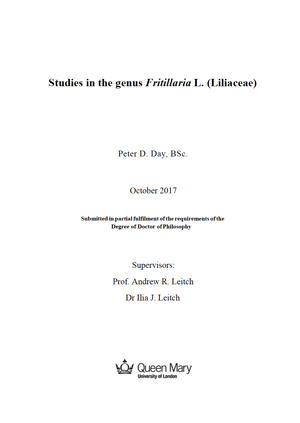NEWS 2017
Studies in the genus Fritillaria L. (Liliaceae)
Peter D DAY
PhD Theses (2017)
Queen Mary, University of London
http://qmro.qmul.ac.uk/xmlui/handle/123456789/36670
Abstract
Genus Fritillaria consists of approximately 140 species of bulbous herbaceous perennials with a bicontinental distribution (Eurasia, North America) across the temperate zone of the Northern Hemisphere. The genus includes species of horticultural commercial value and those used in Traditional Chinese Medicine (TCM) preparations. Since the mid-16th century species within genus Fritillaria have attracted much attention as ornamental plants in the Middle East and Europe. The genus has received much attention by geneticists in recent years because it includes species with an exceptionally large range of genome sizes, including a subgenus containing some of the largest diploid genome sizes so far recorded in plants. This thesis first presents the most comprehensive analysis of the phylogenetic relationships between the species to date, published in 2014 in Molecular Phylogenetics and Evolution. The work reveals two distinctive clades, one containing a small number of species from N. America and N. E. Asia and the other, with the majority of species, found in Europe, N. Africa, Middle East, China and Japan. This phylogenetic distribution of Fritillaria species indicates that two independent shifts towards giant genomes have taken place during evolution of the genus. One particularly charismatic species occurring across Eurasia is the Snake’s-head Fritillary (F. meleagris) with both horticultural and conservation importance. The thesis presents new genetic markers to analyse the relationships between populations of F. meleagris across Eurasia. Three distinct populations were found, in Northern Europe/Scandinavia, Eastern Europe and the Russian Federation. All the English populations are almost certainly derived from populations originally occurring in Northern Europe and likely introduced into England through multiple introductions. However, its origin in the British Isles remains a mystery, although recent research within this project has thrown new light on the history of its first record and description in France and its early presence in Britain.




